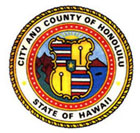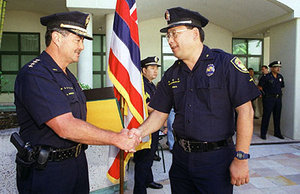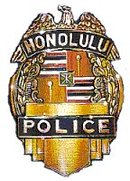Honolulu Police Department
|
|
The Honolulu Police Department, popularly known as HPD, is the principal law enforcement agency of the City & County of Honolulu, USA, under the jurisdiction of the mayor of Honolulu. It is nationally accredited by the Commission on Accreditation for Law Enforcement Agencies.
Founded in 1932, the Honolulu Police Department serves and protects the entire island of O'ahu, covering over 600 square miles (1,600 km²) of territory, home to more than 880,000 residents and over 4 million annual visitors attracted by Honolulu's academic and tourism industries. Unlike the other forty-nine states of the Union, Hawai'i does not have a state police agency or individual city agencies. Law enforcement is the jurisdiction of the individual county governments.
| Contents |
|
|
Kingdom of Hawai'i
In 1840, the Supreme Court of Kamehameha III established the first constitution for the Kingdom of Hawai'i. The constitution paved the way for the Act to Organize the Executive Departments of the Government signed on April 27, 1846. The law created the office of marshal of the kingdom, the highest ranking police officer in the nation. He nominated, instructed, supervised and controlled the sheriffs of the kingdom of which there were four, one for each administrative region of Kaua'i, O'ahu, Mau'i and Hawai'i. Each sheriff administered a corps of constables officially appointed by the four royal governors. Constables wore a distinct police insignia that consisted of a scarlet crown with the initials KIII in honor of Kamehameha III. The insignia was worn on the arm and on a red band on their police hats.
Territory of Hawai'i
In 1893, the Kingdom of Hawai'i was replaced by the Provisional Government of Hawai'i which quickly deposed the marshal of the kingdom and dissolved the constabulary. In 1894, the newly proclaimed Republic of Hawai'i formed its own police system.
After a few years under the governance of the Territory of Hawai'i, four county governments were established out of the original administrative regions of the monarchy. In 1905, each county was equipped with a police department led by an appointed sheriff. Police officers wore an octagon-shaped police badge similar in appearance to those of other police departments of the period. In the 1920s the badge was redesigned with an eagle on top.
Sheriffs of Honolulu
The Office of Sheriff of Honolulu was officially dissolved in 1927 and replaced with a minor bureaucratic position.
- A. M. Brown, 1905-1906
- Curtis P. Iaukea, 1907-1909
- William P. Jarrett, 1910-1914
- Charles G. Rose, 1915-1923
- David K. Trask, 1924-1926
- David L. Desha, 1927
Establishment
In response to a crime wave in the late 1920s as a result of increased racial tensions between whites and local ethnics, Territorial Governor Lawrence M. Judd appointed a Governor's Advisory Committee on Crime. The committee recommended that a police commission be appointed by the mayor of Honolulu whose duty it would be to appoint a chief of police and to supervise the operating of the police department. The committee also advised that the office of sheriff should be retained and charged with the duty of serving civil process, of maintaining the Honolulu prison system and to act as coroner. On January 22, 1932, a special session of the territorial legislature passed Act 1 establishing the Honolulu Police Commission and creating the office of chief of police. Thus was born the modern Honolulu Police Department as it exists today.
Martial law
Upon the attack by Japanese naval forces of Honolulu on December 7, 1941, Territorial Governor Joseph B. Poindexter declared martial law and Hawai'i fell under military governance under the Judge Advocate General's Corps. The Honolulu Police Department became a deputized military force. The word Honolulu was etched-out from the seven-point star badges of police officers and replaced with the word Emergency. For the duration of World War II, the Honolulu Police Department was forced to impose restrictions on civil liberties and hand people over for trial by a military judge. Martial law was dissolved in 1945.
Modernization
The first instance of modernization came in 1952 with the introduction of the Honolulu Police Department's current badge. It was designed by Detective Alfred Karratti and embodies Hawaiian tradition and culture in its motifs. One feature that Detective Karratti kept was the use of the Pulo'ulo'u or kapu staffs. They are symbols of law and order from ancient Hawai'i.
The most aggressive programs of modernization for the Honolulu Police Department came in the 1990s. It was furnished with a fleet of new Ford Crown Victoria police cars equipped with on-board computers and a fleet of BMW and Harley-Davidson motorcycles. On October 16, 1992, the Honolulu Police Department opened its multi-million dollar state-of-the-art police headquarters in downtown Honolulu. The building was called Hale Maka'i and featured the latest technical advances of its time including a DNA crime lab unit, one of the first of its kind in the nation.
Fictional Detectives
Hawaiifiveobadge.jpg
The Honolulu Police Department has been the backdrop of several famous works of fiction, in literature, television and in motion pictures.
Charlie Chan
One of the most famous fictional literary detectives attached to the Honolulu Police Department was Charlie Chan. Chan, inspired in part by the career of real-life HPD vice detective Chang Apana (http://www.honolulupd.org/museum/apana.htm), was created in the 1920s by Earl Derr Biggers and had become one of the most important figures in American mystery fiction. In addition to being the hero of six novels, Chan became the subject of some forty films between the 1930s and 1950s. He, along with his family, was also made the subject of a short-lived cartoon series.
Hawaiian Eye
From October 1959 to September 1963, Hawaiian Eye was a crime drama aired on the American Broadcasting Company television network. Actors Robert Conrad and Anthony Eisley played detectives in Honolulu fighting crime. Connie Stevens played Cricket, a singer at the Hawaiian Village Hotel bar which the guys frequented at least once a show.
Hawai'i 5-0
The most famous Hawai'i based crime drama was Hawai'i 5-0 which aired on the Columbia Broadcasting System television network from September 1968 to April 1980. Until Law & Order, Hawai'i 5-0 was the longest running crime series on American television. Jack Lord starred as Steve McGarrett, head of the elite state law enforcement office which worked alongside the chief of the Honolulu Police Department. James MacArthur starred as Danny Williams, McGarrett's right-hand man. Straight-jawed men with shellacked hair fought forces of evil around the islands, especially in seedy downtown dives.
Magnum, P.I.
From December 1980 to September 1988, Magnum, P.I. aired on the same network as Hawai'i 5-0. Starring Tom Selleck as former naval intelligence officer Thomas Magnum, Magnum, P.I. is about a private investigator working closely with Honolulu Police Department officers Nolan Page and Yoshi Tanaka. The series was widely applauded for being the first to recognize the difficulty Vietnam War veterans faced in making the readjustment to civilian life. Many episodes touched upon the impact that serving in Vietnam had on Magnum and his friends, as well as echoes to events of World War II.
Jake and the Fatman
From September 1987 to March 1992, Columbia Broadcasting Company aired a spin-off for a Matlock character. The show was called Jake and the Fatman about Hawai'i district attorney from Los Angeles Jason Lochinvar "Fatman" McCabe played by William Conrad and his special investigator Jake Styles played by Joe Penny. Working closely with the Honolulu Police Department, the duo strived to put every major mob criminal in Hawai'i behind bars.
Hawai'i
In August 2004, the NBC Universal Television introduced the police series Hawai'i. The show featured an elite Honolulu Police Department detective squad charged with fighting the most notorious of Hawai'i mob criminals. Starring in the show were Michael Biehn from The Terminator as Max Harrison, Sharif Atkins from ER as John Decian, Ivan Sergei from Crossing Jordan, Eric Balfour from Six Feet Under as Christopher Gains, and newcomers Aya Sumika as Linh Dias and Cary Tagawa as Captain Terry Harada. Jeff Eastin was the creator and executive producer. Daniel Sackheim from the defunct series The Lyons Den directed. The series was cancelled after eight episodes, partly due to strong competition from another show produced in Hawaii, ABC's Lost.
Resources
- Honolulu Police Department (http://www.honolulupd.org/index.html)



